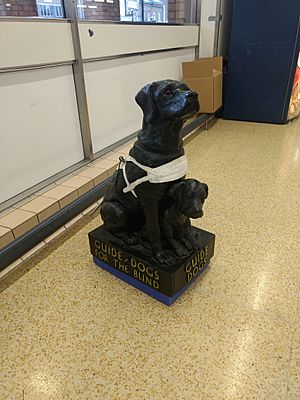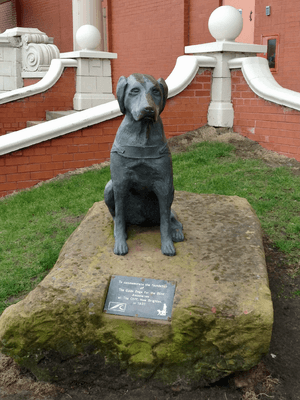The Guide Dogs for the Blind Association facts for kids
| Abbreviation | Guide Dogs |
|---|---|
| Formation | 30 August 1934 |
| Type | Charity |
| Jamie Hambro | |
| Tom Wright | |
|
Staff
|
1400 |
|
Volunteers
|
10000 |
| Website | http://www.guidedogs.org.uk |
The Guide Dogs for the Blind Association, often called Guide Dogs, is a British charity. It started in 1934.
Guide Dogs helps people in the UK who are blind or can't see very well. They do this by providing guide dogs. They also offer services to help people move around safely and live more independently. The charity works to protect the rights of people with sight loss. They also support research into eye diseases.
Their main office is near Reading in Berkshire. There are four Guide Dog Training Schools in the UK. These are in Woodford Bridge, Leamington, Atherton, and Forfar in Scotland. They also have a special place for breeding dogs near Leamington. Plus, there are 20 teams that help people with mobility and many groups that raise money across the UK. In 2017, the charity had an issue with how it handled some personal information from donors.
Contents
How Guide Dogs Help People
The guide dog service gives a guide dog to a person who is blind or has low vision. These special dogs are born at the homes of volunteers. When the puppies are six weeks old, they move to another volunteer's home. These volunteers are called puppy walkers.
After about 12 to 14 months, the young dogs go to a special trainer. They train for around 26 weeks to learn important skills. This training includes three to five weeks of working closely with their new owner. Every person and dog is different. So, finding the perfect guide dog for an owner is a careful process. Trainers consider everything about a person, like how fast they walk, their height, and their daily life.
Guide Dogs promises to support the partnership between the person and their guide dog for as long as needed. A person might have up to eight guide dogs in their lifetime. After working for six or seven years, a guide dog retires and finds a new home to live in.
Guide Dogs is a world leader in breeding and training guide dogs. They even helped start the International Guide Dog Federation.
Right now, there are about 4,800 working guide dog teams in the UK. More than 1,300 puppies are born each year. Guide dog owners only pay a small amount (50p) for their dog. This makes sure that everyone can have a guide dog, no matter how much money they have. However, the full cost of raising and training a guide dog from birth to retirement is around £50,000. The charity gets all its money from donations and gifts left in wills.
Sometimes, dogs are not allowed in places like restaurants or food shops. But guide dogs and other assistance dogs are legally allowed to enter these places. This is thanks to laws like the Equality Act 2010 in the UK. Even so, there are still times when guide dog users are refused entry to shops, restaurants, or taxis. The Guide Dogs charity works with guide dog users and businesses to teach people about the law. They also help people make official complaints when this happens.
History of Guide Dogs
The first four British guide dogs were Judy, Flash, Folly, and Meta. They finished their training in 1931 in Wallasey, Wirral. Three years later, The Guide Dogs for the Blind Association was officially formed. This was possible because of Muriel Crooke and Rosamund Bond. They were German shepherd breeders who trained these first guide dogs.
The first full-time trainer for Guide Dogs was Captain Nikolai Liakhoff. He came to England in 1933. In 1941, the charity's building in Wallasey was needed for the war. So, Guide Dogs moved to a new place in the middle of England, in Leamington Spa.
In 1956, Guide Dogs started asking for volunteers to be puppy walkers. A few years later, they began a special breeding program. By 1970, these parts of Guide Dogs' work had grown so much that they got their own building called Tollgate House, near Leamington Spa. A very important person in developing these programs was Derek Freeman MBE.
In 1964, many children learned about the charity through the TV show Blue Peter. The show asked viewers to collect silver foil and milk bottle tops. Blue Peter raised enough money to pay for two guide dog puppies, Cindy and Honey. The show followed their training journey. This idea was used again in the early 1980s, in 2006 with Andy Akinwolere and a puppy named Magic, and in 2014 with another puppy, Iggy.
In 2007, working with the BBC Breakfast TV show, Guide Dogs started an annual award. It's called the 'Guide Dog of the Year' award. It celebrates the amazing things individual guide dogs do.
Volunteering with Guide Dogs
Guide Dogs relies on many volunteers to help with their work. Here are some key ways volunteers help:
- Puppy walking: Volunteers take a puppy into their home for 12 to 14 months. They help the puppy get used to everyday sights and sounds.
- Boarding: These volunteers look after trainee guide dogs in the evenings and on weekends.
- Breeding stock holders: They care for the female dogs that will have puppies and the male dogs used for breeding.
- Drivers: Volunteers help transport dogs and people.
- Branch roles: These include jobs like treasurer or supporter for local fundraising groups.
- Fundraising: Volunteers help raise money to support the charity's work.
Campaigning for Change
Guide Dogs works to change things that make it harder for blind and partially sighted people to live freely. For example, they push for:
- Buses to have audio and visual announcements.
- Equal access to taxis for guide dog users.
- Shops, restaurants, and banks to provide services that meet the needs of people with sight loss.
Guide Dogs is also involved in discussions about "shared space" streets in the UK. They campaign for safer streets. This means working with local councils and politicians to make people aware of dangers on sidewalks. Obstacles on streets can be very dangerous for blind and partially sighted people.
Research at Guide Dogs
Since 1990, Guide Dogs has given money for eye research. This research looks for ways to protect sight and stop further vision loss. It also aims to find better ways to diagnose and treat eye conditions. As part of this program, Guide Dogs has funded studies like:
- Looking into a possible new treatment for an inherited type of blindness called Leber's congenital amaurosis (LCA).
- A study to make it easier and more accurate to check vision in children. This helps doctors better diagnose and watch eye conditions.
- Research to understand how different genes can change a person's risk of getting age-related macular degeneration (AMD) later in life.
Guide Dogs also does research on dogs themselves. This helps ensure the health, happiness, and performance of their guide dogs. They also do research about the well-being of people who are blind or partially sighted.
Guide Dog of the Year Award
The 'Guide Dog of the Year' is an annual awards event run by Guide Dogs. It celebrates the great work of the 4,700 guide dogs helping their owners across the UK. In 2014, the Inspirational Guide Dog Owner of the Year award went to Verity Smith and her guide dog Uffa.
Pavement Parking Campaign
Guide Dogs campaigns against cars parking on pavements. Many other charities also support this cause. The campaign supported a bill that would have made it illegal to park on pavements across England and Wales, unless specifically allowed. This bill was introduced in 2014–15 but did not become a law.



